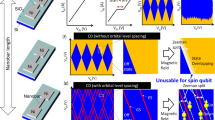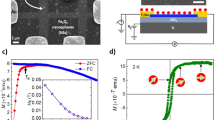Abstract
Graphene has unique electronic properties1,2, and graphene nanoribbons are of particular interest because they exhibit a conduction bandgap that arises due to size confinement and edge effects3,4,5,6,7,8,9,10,11. Theoretical studies have suggested that graphene nanoribbons could have interesting magneto-electronic properties, with a very large predicted magnetoresistance4,12,13,14,15,16,17,18,19,20. Here, we report the experimental observation of a significant enhancement in the conductance of a graphene nanoribbon field-effect transistor by a perpendicular magnetic field. A negative magnetoresistance of nearly 100% was observed at low temperatures, with over 50% magnetoresistance remaining at room temperature. This magnetoresistance can be tuned by varying the gate or source–drain bias. We also find that the charge transport in the nanoribbons is not significantly modified by an in-plane magnetic field. The large observed values of magnetoresistance may be attributed to the reduction of quantum confinement through the formation of cyclotron orbits and the delocalization effect under the perpendicular magnetic field15,16,17,18,19,20.
This is a preview of subscription content, access via your institution
Access options
Subscribe to this journal
Receive 12 print issues and online access
$259.00 per year
only $21.58 per issue
Buy this article
- Purchase on Springer Link
- Instant access to full article PDF
Prices may be subject to local taxes which are calculated during checkout





Similar content being viewed by others
References
Geim, A. K. & Novoselov, K. S. The rise of graphene. Nature Mater. 6, 183–191 (2007).
Castro Neto, A. H., Guinea, F., Peres, N. M. R., Novoselov, K. S. & Geim, A. K. The electronic properties of graphene. Rev. Mod. Phys. 81, 109–162 (2009).
Nakada, K., Fujita, M., Dresselhaus, G. & Dresselhaus, M. S. Edge state in graphene ribbons: nanometer size effect and edge shape dependence. Phys. Rev. B 54, 17954–17961 (1996).
Son, Y. W., Cohen, M. L. & Louie, S. G. Energy gaps in graphene nanoribbons. Phys. Rev. Lett. 97, 216803 (2006).
Sols, F., Guinea, F. & Neto, A. H. C. Coulomb blockade in graphene nanoribbons. Phys. Rev. Lett. 99, 166803 (2007).
Gunlycke, D., Areshkin, D. A. & White, C. T. Semiconducting graphene nanostrips with edge disorder. Appl. Phys. Lett. 90, 142104 (2007).
Adam, S., Cho, S., Fuhrer, M. S. & Das Sarma, S. Density inhomogeneity driven percolation metal–insulator transition and dimensional crossover in graphene nanoribbons. Phys. Rev. Lett. 101, 046404 (2008).
Stampfer, C. et al. Energy gaps in etched graphene nanoribbons. Phys. Rev. Lett. 102, 056403 (2009).
Han, M. Y., Ozyilmaz, B., Zhang, Y. B. & Kim, P. Energy bandgap engineering of graphene nanoribbons. Phys. Rev. Lett. 98, 206805 (2007).
Li, X. L., Wang, X. R., Zhang, L., Lee, S. W. & Dai, H. J. Chemically derived, ultrasmooth graphene nanoribbon semiconductors. Science 319, 1229–1232 (2008).
Bai, J. W., Duan, X. F. & Huang, Y. Rational fabrication of graphene nanoribbons using a nanowire etch mask. Nano. Lett. 9, 2083–2087 (2009).
Son, Y. W., Cohen, M. L. & Louie, S. G. Half-metallic graphene nanoribbons. Nature 444, 347–349 (2006).
Kim, W. Y. & Kim, K. S. Prediction of very large values of magnetoresistance in a graphene nanoribbon device. Nature Nanotech. 3, 408–412 (2008).
Munoz-Rojas, F., Fernandez-Rossier, J. & Palacios, J. J. Giant magnetoresistance in ultrasmall graphene based devices. Phys. Rev. Lett. 102, 136810 (2009).
Peres, N. M. R., Castro Neto, A. H. & Guinea, F. Dirac fermion confinement in graphene. Phys. Rev. B 73, 241403 (2006).
Peres, N. M. R., Castro Neto, A. H. & Guinea, F. Conductance quantization in mesoscopic graphene. Phys. Rev. B 73, 195411 (2006).
Huang, Y., Chang, C. P. & Lin, M. F. Magnetic and quantum confinement effects on electronic and optical properties of graphene ribbons. Nanotechnology 18, 495401 (2007).
Liu, J., Wright, A. R., Zhang, C. & Ma, Z. Strong terahertz conductance of graphene nanoribbons under a magnetic field. Appl. Phys. Lett. 93, 041106 (2008).
Ritter, C., Makler, S. S. & Latge, A. Energy-gap modulations of graphene ribbons under external fields: a theoretical study. Phys. Rev. B 77, 195443 (2008).
Li, T. S., Huang, Y. C., Chang, S. C., Chang, C. P. & Lin, M. F. Magnetoconductance of graphene nanoribbons. Phil. Mag. 89, 697–709 (2009).
Lin, Y. M., Perebeinos, V., Chen, Z. H. & Avouris, P. Electrical observation of subband formation in graphene nanoribbons. Phys. Rev. B 78, 161409 (2008).
Gallagher, P., Todd, K. & Foldhaber-Gordon, D. Disorder-induced gap behavior in graphene nanoribbons. Phys. Rev. B 81, 115409 (2010).
Han, M. Y., Brant, J. C. & Kim, P. Electron transport in disordered graphene nanoribbons. Phys. Rev. Lett. 104, 056801 (2010).
Ozyilmaz, B., Jarillo-Herrero, P., Efetov, D. & Kim, P. Electronic transport in locally gated graphene nanoconstrictions. Appl. Phys. Lett. 91, 192107 (2007).
Scott Bunch, J. S., Yaish, Y., Brink, M., Bolotin, K. & McEuen, P. L. Coulomb osillations and Hall effect in quasi-2D graphite quantum dots. Nano Lett. 5, 287–290 (2005).
Ponomarenko, L. A. et al. Chaotic Dirac billiard in graphene quantum dots. Science 320, 356–358 (2008).
Cho, S. & Fuhrer, M. S. Charge transport and inhomogeneity near the minimum conductivity point in graphene. Phys. Rev. B 77, 081402 (2008).
Martin, J. et al. Observation of electron–hole puddles in graphene using a scanning single-electron transistor. Nature Phys. 4, 144–148 (2008).
Sahoo, S. et al. Electric field control of spin transport. Nature Phys. 1, 99–102 (2005).
Hamaya, K. et al. Electric-field control of tunneling magnetoresistance effect in a Ni/InAs/Ni quantum-dot spin valve. Appl. Phys. Lett. 91, 022107 (2007).
Martin, I. & Blanter, Y. M. Transport in disordered graphene nanoribbons. Phys. Rev. B 79, 235132 (2009).
Gershenson, M. E., Khavin, Y. B., Mikhalchuk, A. G., Bozler, H. M. & Bogdanov, A. L. Crossover from weak to strong localization in quasi-one-dimensional conductors. Phys. Rev. Lett. 79, 725–728 (1997).
Poumirol, J. M. et al. Edge magneto-fingerprints in disordered graphene nanoribbons. Preprint at arXiv: 1002.4571v1 (2010).
Oostinga, J. B., Sacepe, B., Cracium, M. F. & Morpurgo, A. F. Magneto-transport through graphene nanoribbons. Preprint at arXiv: 1003.2994v1 (2010).
Acknowledgements
The authors would like to acknowledge technical support from the Center for Quantum Research and the Nanoelectronics Research Facility at UCLA. The authors thank D. Newhauser and Y. Tserkovnyak for discussions. Y.H. acknowledges support from the Henry Samueli School of Engineering and an Applied Science Fellowship. X.D. acknowledges support from NSF CAREER award 0956171 and the NIH Director's New Innovator Award Program, part of the NIH Roadmap for Medical Research, through grant no. 1DP2OD004342-01.
Author information
Authors and Affiliations
Contributions
X.D., Y.H., J.B., R.C. and L.L. conceived and designed the experiments. J.B., C.R., F.X. and A.S. performed the experiments. J.B. and C.R. collected and analysed the data. M.W., A.S. and K.W. contributed experimental tools. J.B., C.R., Y.H. and X.D. co-wrote the paper. All authors discussed the results and commented on the manuscript.
Corresponding authors
Ethics declarations
Competing interests
The authors declare no competing financial interests.
Supplementary information
Supplementary information
Supplementary information (PDF 965 kb)
Rights and permissions
About this article
Cite this article
Bai, J., Cheng, R., Xiu, F. et al. Very large magnetoresistance in graphene nanoribbons. Nature Nanotech 5, 655–659 (2010). https://doi.org/10.1038/nnano.2010.154
Received:
Accepted:
Published:
Issue Date:
DOI: https://doi.org/10.1038/nnano.2010.154
This article is cited by
-
Precise control of graphene etching by remote hydrogen plasma
Nano Research (2019)
-
Spin Transport in Zigzag Graphene Nanoribbon with a Flower Defect
Journal of Superconductivity and Novel Magnetism (2019)
-
Multiple thermal spin transport performances of graphene nanoribbon heterojuction co-doped with Nitrogen and Boron
Scientific Reports (2017)
-
Cascaded spintronic logic with low-dimensional carbon
Nature Communications (2017)
-
The Effects of Negative Differential Resistance, Bipolar Spin-Filtering, and Spin-Rectifying on Step-Like Zigzag Graphene Nanoribbons Heterojunctions with Single or Double Edge-Saturated Hydrogen
Journal of Electronic Materials (2017)



